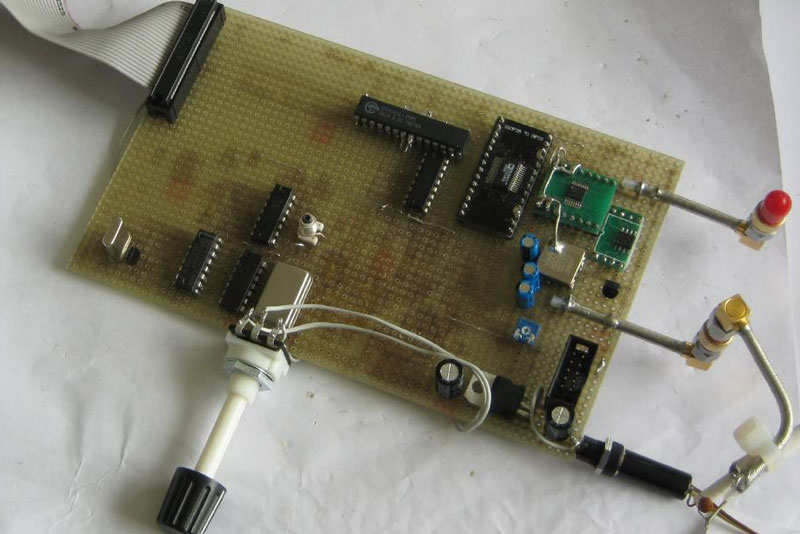Want to set up your own television station? This hack might help: [Jan Panteltje] has worked out how to turn a Raspberry Pi into a DVB-S transmitter. DVB-S is a TV transmission standard originally created for satellite broadcasts, but Hams also use it to send video on the amateur bands. What [Jan] did was to use software on the Pi to encode the video into the transport stream, which is then fed out to the home-made transmitter that modulates the data into a DVB-S signal. [Jan] has successfully tested the system with a direct connection, feeding the output of the transmitter into a DVB-S decoder card that could read the data and decode the video signal. To create a real broadcast signal, the next step would be to feed the output of the signal into an amplifier and larger transmitter that broadcast the signal.
That’s a big step, though, and I hope that [Jan] holds off and does a bit more documentation first. At the moment, the schematics for this are all hand-drawn, and the prototype is a wire-wrapped bit of protoboard. This is a very impressive hack, though: there are amateur DVB-S transmitters available, but most put the encoding onto a dedicated chip. We’ve seen hacks using the simpler DVB-T standard and a Pi before, but getting a Pi to do some of the heavy lifting makes it cheaper and more flexible, so kudos to [Jan] and colleagues for their work.

















Might be possible to get the Pi to transmit an old style NTSC signal to a low frequency channel like channel 2 without external hardware? I know it can xmit rf at those frequencies… some software, a bit of wire for an antenna and perhaps a bit of smoothing of the harsh square wave signal….
Try outputtimg a >50Mhz signal and look at it on a scope. It will look more like a sin wave than a square wave.
– and if you run it through an LC tank circuit, even more lie a sin wave
That is probably a result of your measurement technique, the rise times directly out of a raspi are just 1-2ns
Who enunciates ‘H’ as ‘aytchie’? It’s either ‘aytch’ or ‘haytch’.
‘H’ ‘E’
there isn’t an ‘he’ in that sentence. they’re using it to mean ‘h’
transmitting TV from a pie
Why?
Why not?
Where does the LNB come in?
DVB-S signals are transmittet by the satellite at above 10GHz.
The LNB is responsible for shifting down these signals to less than 2.4GHz so that it can travel through a cable without too much cable loss.
What he has made can be plugged directly into the receiver, no LNB needed.
You just need to account the amount the the LNB down shifts the signal (the L.O frequency) when configuring the receiver.
You might want to add an DC blocking capacitor! I guess the Rpi isn’t happy about the 14/18V coming from the receiver ;)
Ahrg i was refering to the “UglyDTV” thing , nevermind.
I know this guy, he is the Big Chief Writing Tablet guy
i dont give shit how many smurfs you have to kill captain make it happen
Wouldn’t this have been easier to do with GNURadio?
Thats not wire wrapping, thats point to point soldering…
WTF Only one person pointing this out. Perhaps Dick Bag-uley should know the meaning of wire wrapping before writing about it.
This one also looks similar… esp the noisy “Ugly” mode without any extra circuitry – for low sample rates(only?)….
http://f5oeo.fr/UglyDATV01.pdf
Thanks in mentionning UglyDATV…main difference is there is NO need of extra hardware ! RF is output on GPIO like on rpitx (it is weird, but I began with TV before modulating SSB one year ago : https://twitter.com/F5OEOEvariste/status/509022026166960128 )
so its 2 fifos in series to smooth any jitter from linux bitbanging GPIO, nice solution
then 74153 demultiplexer + CD 4040 realizing a double 4 bit serializer, again pretty cool
finally digitial I and Q are mixed together using 100MHz oscillator divided by 4 = they are shifter by 90 degrees
after that its filtered and mixed with proper carrier
I appreciate him using old old school components, whole thing could fit in a 10 year old $2 CPLD, but this way its easier to understand whats going on by just looking at the schematic
I think Pees DPI (digital parallel video output) could be used in combination with http://bellard.org/dvbt/ as another way of achieving same goal.
I would love to do DVB-T without the expensive UT100C modulator. Since most modern TVs can recieve it without any additional hardwire it would be very cool.
I wonder if it can be done like PiFM?
A typed Bill Of Materials would be useful…
AD9761
http://www.analog.com/en/products/digital-to-analog-converters/da-converters/ad5346.html#product-samplebuy
go and buy a pluto or lime
can do narrow band datv what we hams use with datv express software